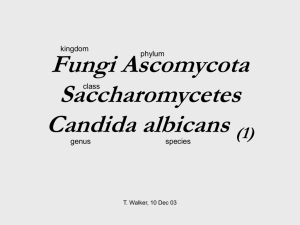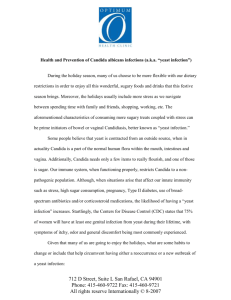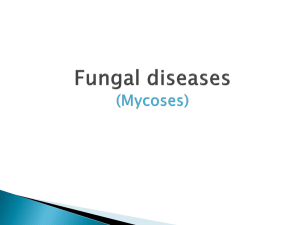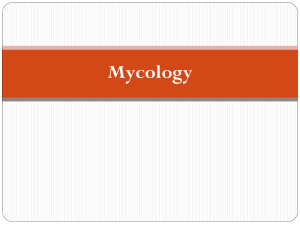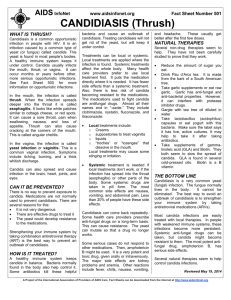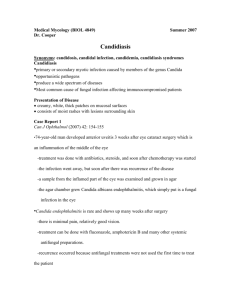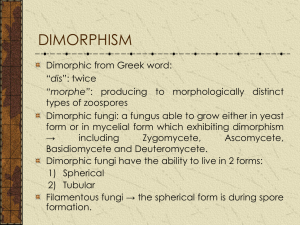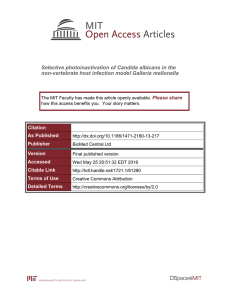Jennifer Chan- " Candida albicans
advertisement
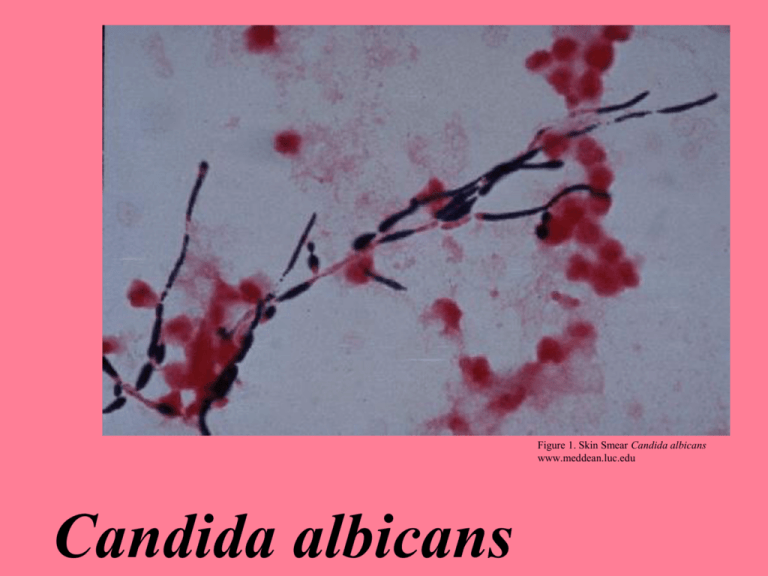
Figure 1. Skin Smear Candida albicans www.meddean.luc.edu Candida albicans Contents 1. 2. 3. 4. 5. 6. 7. Introduction to Mycology Biological Profile Disease capabilities Pathogenesis Detection Drug therapy Research The Situation Frequency - most common fungal pathogen worldwide - 4th leading causes of nosocomial infections, 40% mortality - significant mortality and morbidity in low birth-weight infants - affects 75% women, 45% experience recurrenceA > 10 million visits/year - classified as a STD by CDC Immunocompromised - cancer and HIV-AIDs patientsC - most commonly manifested in patients with leukemia or HIV-AIDs infections. Oral candidiasis is often a clue to acute primary infectionC Public Concerns - increasing resistance to drug therapies due to antibiotics and antifungals Mycology Basics Kingdom: Fungi More than 10 million species, but only ~400 human disease (*) Sexual Groups Ascomycota* Basidiomycota* Zygomycota* Chytridia Fungi Imperfecti* www.ken.coar.org www.arboretum.harvard.edu Very few species are in a commensal relationship with humans - includes Candida albicans and Malasezia furfur Diseases caused by fungi are usually accidental www.bio.umass.edu Endogenous and Exogenous Sources Increasing problem due to antibacterial & immunosuppressive agents Molecular mechanisms of pathogenesis not well-defined The 5 main groups Figure 1. Classification of Fungi. Fungi are classified based on their ability to reproduce sexually, asexually, by a combination of both. The different reproductive structures places them in the appropriate category. (Baron, 1996) Fungal Characteristics Plant-like lacking chlorophyll Cell wall chitinous matrix Free-living saprobes and heterotrophs needs Carbon source and Nitrogen source Yeasts or Molds or both Figure 1. Penicillium chrysogenum www.doctorfungus.org Success of an infection Accidental Overcoming host barriers Presiding in host with immunological defects Yeast Characteristics Mould Characteristics solitary, unicellular filamentous hyphae reproduction via budding hyphal formation rounded shape tips may be rounded (conidia/spores) moist & mucoid colonies Figure 1. Typical Yeast Figure 2. Typical mould Yeast Bud Formation Figure 1. Stages of bud growth and yeast cell cycle (Baron et. Al., 1996) Hyphal Formation Figure 1. Polarized hyphal formation (Baron et. Al., 1996) Biology of Candida albicans Commensal Pathogen A thin-walled dimorphic fungus Morphogenesis Unicellular yeast (harmeless) Filamentous (pathogenic) Principal Cell Wall Polymers Gluccan Mannan Figure 1. Yeast in Oral Scraping A sample of an oral scraping contains yeast cells and pseudohyphae (www.doctorfungus.org) Strict aerobe, favors moist surfaces Commensally found in gut, genitals, and lungs Body Temp 37º C, neutral pH Rapid Multiplication & Spread Diseases by C. albicans Thrush Esophagitis Cutaneous Candidiasis Genital Yeast Infections Deep Candidiasis Oropharyngeal Thrush * Pseudomembranous * Atrophic * Angular chelitis Figure 1. Angular chelitis (www.emed.com) Symptoms Risk Factors HIV Treatment: topical antifungals Figure 2. Oral Thrush, atrophic (www.mycolog.com) Figure 3. Oral Thrush, pseudomembranous (www.emed.com) Genital Yeast Candidiasis Symptoms Risk Factors - disruption of normal microbiota Figure 1. Vaginal Yeast Culture (www.euromeds.co.uk) Treatment - direct genital administration - tablets, suppositories, creams Figure 2. Plasma cell balanitis. A band-like infiltrate of plasma cells is in the dermis of the male penis. (www.webpathology.com) Deep Candidiasis Figure 1. Four forms of invasive candidiasis (www.doctorfungus.org) Pathogenesis Host Recognition Adhesins Enzymes Hydrolases: Phosphoplipases, Lipases, Proteinases Morphogenesis Yeast form to Filamentous hyphae/pseudohyphae Phenotypic Switching Virulence assay of different C. albicans strains using the skin equivalent (AST 2000) Figure 1. skin equivalent before infection Figure 2. Infection with pathogenic clinical isolate of C. albicans. After 48 h the yeast penetrates the skin equivalent and destroys the tissue Figure 3. Infection with non-pathogenic C. albicans. This strain is not able to penetrate into the tissue and thus behaves as avirulent as shown in the mouse model of systemic infection. (Fraunhofer, 2002) MORPHOGENESIS Figure 1. Morphogenesis. Morphogenesis in C. albicans is a pivotal virulence factor that allows rapid multiplication and subsequent dissemination in host tissue. (www.kent.ac.uk) Figure 2. Morphogenic forms of Candida albicans http://cbr-rbc.nrc-cnrc.gc.ca/thomaslab/candida/caindex.html Tools for Detection & Diagnosis Old Methods Restriction Enzyme Analysis Current methods Culture and Serology PCR Based Molecular Techniques QuickTime™ and a TIFF (Uncompressed) decompressor are needed to see this picture. targets SAPs Advantages Disadvantages Future Non-PCR Based Fluorescent in situ hybridization Fig. 1. Throat Swab (www.nlm.nih.gov) Current Drug Therapies Major Drug Categories Polyenes Problems: Catalase activity, ergosterol production Azoles Problems: Enhanced drug efflux FDA approved antifungal drugs Amphotericin B (Fungizone) Clotrimazole (Mycelex) Fluconazole (Diflucan) Itraconazole (Sporanox) Ketoconazole (Nizoral) Nystatin (Mycostatin) QuickTi me™ and a TIFF ( Uncompressed) decompressor are needed to see thi s pi ctur e. Fig. 1. Fungizone (www.bms.se) Medical Economics. Drug Topics Red Book. Montvale, NJ: Medical Economics Co., Inc., 2000. Research •Biotechnological methods for rapid identification and detection of Candida strains •New antifungal agents •Molecular pathogenesis •Emerging opportunistic strains •Public Health Measures in limiting nosocomial-related infections References 1. Bailli e, GS and LJ Doug las. 1999. Ro le of dimorphism i n the deve lopment of Candida albicans bio film e. J. Med. Microbiol. 48:671-679. 2. Brown , JP. 2002. Morphog enetic Signa li ng Pathways in Candida albicans. Washington: ASM Press: Candida and Cand idiasis. pp. 95-106. 3. Calderone , R.A. (ed.). Candida and Cand idiasis. Wash ington: ASM Press; 2002. 4. Calderone R and N.A .R. Gow. 2002. Host recogn iti on by Candida species. Washington: ASM Press: Candida and Cand idiasis. pp. 67-86. 5. Cormack, B.P., N. Ghor i, and s. Falkow. 1999. An adhe sin o f the yea st pathogen Candidia glabrata mediating adhe renc e to hu ma n ep it heli al cell s. Science 285: 578-582. 6. Ghannou m, MA. 2000. Potential r ole of pho spholi paes in v ir ulence and funga l pathogene sis. Cli n Micro Review. 13(1): 122-143. 7. Gow, NAR. 2002. Cell Biology and the Cell Cycle of Candida. ASM Press: Candid a and Cand idiasis. pp. 145-158 . 8. Hawser, SP and LJ Doug las. 1994. Biofilm formation by Candida species on the surface of catheter materials in vit ro. Infect. Imm uno. 62:915-921. 9. Jabra-Riz k, MA. Et. al. 2004. Fung al Biofilm s and D rug Resistance . Emerging Infe ctiou s Diseases. 10(1): 14-19. 10. Jarvis , WR. 1995. Epidemi ology of no socomi al funga l infections, with empha sis on Candida species. Clin Infec Dis . 20(6): 1526-30. 11. Nagli k, J.R. et. Al. 2003. Candida albicans Secreted Aspartyl P roteinases in Vir ulence and Pathogen esis. Microbiology and Molecular Biology Reviews. 67(3):400-428. 12. Kwong -Chung , K.J. and J .E. Benne tt. 1992. Medical Myco logy. Lea & Febiger, Phil adelphia. 13. Larone, D.H. 1995. Medicall y Important Fung i – A gu ide to Identifi cation, 3rd ed. ASM Press, Washington, D.C. 14. Marr Ka. Dec. 2004. Invasive Candida Infections; the changing epidemiology. Oncology. 18(14 ): 9-14. 15. Medical Econo mi cs. Drug Topics Red Book. Montvale, NJ: Medical Econo mi cs Co., Inc. , 2000. 16. Mildvan, D. (ed.). 1995. Atlas of Infectious Diseases, vol. I. Current D. www .webpathology.com C. http:/ /www.ncb i. nlm .nih.gov B. http:/ /www.e me dicine.co m/ emerg/topic76.htm A. http:/ /www. inteli hea lt h.com/ IH/ihtIH/WSIHW000/9339/31092.h tml Medicine Inc., New York, New Y ork. 17. Prescott, LM et. al., Mi crobiology. NY: McGraw-H ill; 2002. 18. Soll DR. 1992. High F requency Switching in Candida albicans. Clin Micro Review. 5(2): 183-203. 19. Sulliv an DJ and DC Coleman. 2002. Molecular Approaches to Identification and Typing o f Candida Species. ASM Press: Cand ida and Candidi asis. 20. Suzuk i, S. 2002. Serological diff erences a mong the pathogen ic Candida spp. ASM: Candida and Candidiasis. pp. 29-36 . 21. Raoul t, D. et. al.. 2004. Wha t does the future ho ld for cli nical mi crobiology? Nature Reviews. 2: 151-159. 22. Ruhnk e, M. 2002. Skin and Mucous Me mbrane Infections. ASM Press: Candida and Candidiasis. pp. 307-325 . 23. Burnie J. & R. Matthews. 2003. The role of antibodies against hsp90 in the treatment of fungal infections Drug News Perspect 16(4): 205-210.
